Audio interconnection 11
Audio phase and polarity
- Video
- Script
Welcome to this tutorial on phase and polarity.
Phase and polarity have important implications for audio interconnection. They can be the cause of problems and the solution, and they also have creative applications. A basic understanding is essential for all project studio owners.
Caption - What is phase?
Phase refers to the timing relationship between 2 or more signals. If you record an acoustic guitar with multiple microphones at differing distances, the signals they produce, whilst being of the same performance, will have different phase relationships because the sound-waves reach the microphones at different times. As we will see, this can cause problems.
Caption - In, and out of phase signals
When 2 identical soundwave signals meet they produce a wave that is the sum of their amplitudes, stronger and louder. This is a useful property and one of the advantages of balanced signal transmission. This is true for air pressure sound-waves and electrical and digital sound-waves in an electronic audio system such as a studio.
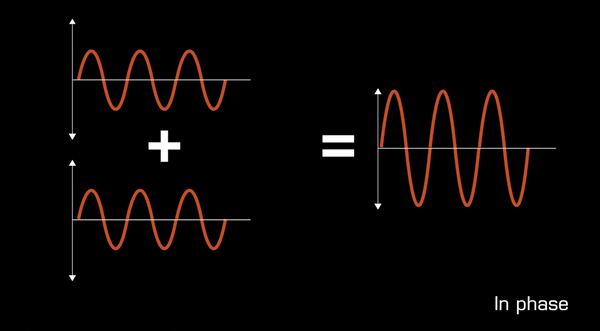
If one of the soundwave signals is the mirror image of the other, or is delayed in time by half a wavelength, they are said to be out of phase and completely cancel each other out. This too is a useful property and exploited by balanced signal transmission.
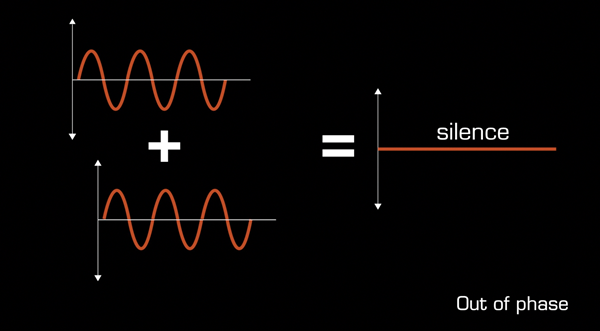
Caption - Expressing phase relationships
These phase relationships can be expressed more precisely in degrees. 2 in-phase signals are said to have a phase relationship of 0 degrees, whilst 2 completely out of phase signals have a phase relationship of 180 degrees.
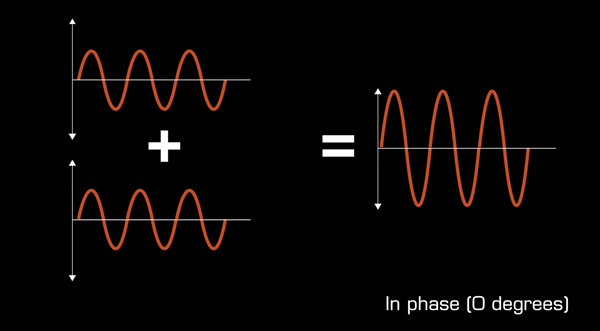

Caption - Phase problems
Phase relationships can cause serious problems in the project studio, such as ..
- reflected sound in a room where recording or monitoring is taking place, as waves reflecting around the room meet and interact thus altering the true level of the recorded sound-waves
- stereo loudspeakers not placed equidistant from the monitoring position
- multiple mic'ing of a single source
- latency in digital systems, particularly DAWs, where multiple channels are routed in complex ways
- latency issues sending and returning signals in and out of DAWs
- related leads of differing lengths
Caption - Phase problem example
Demonstration Consider a snare drum that is being close mic’d from the top and underneath. Each mic hears a different tonal aspect of the overall timbre. When the drum is hit the air pressure on top will drop as the skin moves away from the mic, but underneath the pressure increases as the skin moves towards the mic. Therefore the signals produced by the mic's will be 180 degrees out of phase with each other and when mixed together cancelling of common harmonics will occur. The solution is to use the phase button on one of the mic pre amps to invert the phase of one of the signals. Despite being called Phase buttons, they function as polarity reverse controls.
Caption - What is polarity?
Polarity is a property of individual signals. Almost all audio leads are in effect a circuit requiring at least 2 wires, positive and negative.
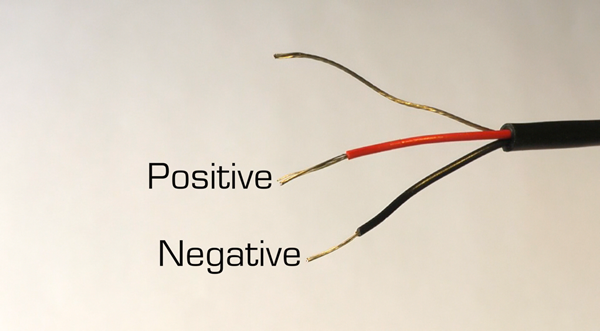

Demonstration For example, if you reverse these wires in a line level signal coming from a monophonic synthesiser you will reverse the polarity of the signal. This will have no audible effect.
Demonstration If it were a stereo synthesiser and you reversed the polarity of the left output but not the right, the 2 signals would be out of phase with each other. In this case, because the left and right outputs share some frequencies, there may be an audible effect, a changing of the timbre of the sound.
Caption - Complex phase relationships
Often the phase relationship between signals will be somewhere in between in-phase and out-of-phase.
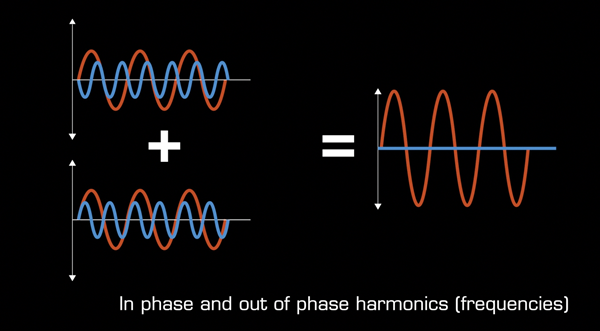
This can happen for many reasons.
Demonstration Mic'ing a guitar with 2 microphones.
Demonstration Non parallel loudspeaker placement.
Caption - Are phase issues always a problem?
Phase issues are not always a problem. Phase relationships help us place a sound in a room and can therefore be an important part of a recording. Also, if the polarity of a single signal is reversed there will be no audible effect. On the other hand, having the polarity of one of your monitor speakers reversed is almost certainly going to be a big problem!
Caption -Eliminating phase issues in a recording setup
If you follow these simple rules, you can use your ears to decide if phase is a problem when using microphones and mixing ..
- ensure your monitor loudspeakers have correct polarity and are equidistant from the monitoring position
- ensure the polarity of all interconnects and leads is correct
- ensure the lead lengths for stereo, and multi-channel connections, are consistent
- take measures to ensure sound-waves reflections in your studio room are minimised, absorbed and randomised
- enable latency compensation in your DAW
Caption - Thanks for watching
The script for this video, with accompanying images, can be found at projectstudiohandbook.com
We suggest you subscribe at our YouTube channel, and join our mailing list at our website to receive notification of new videos, blog posts and subscriber only extras.
Thanks for watching.